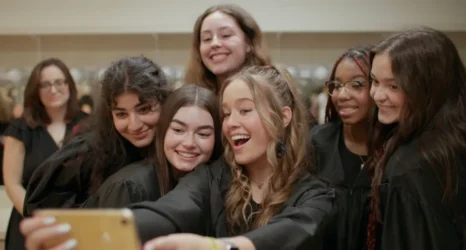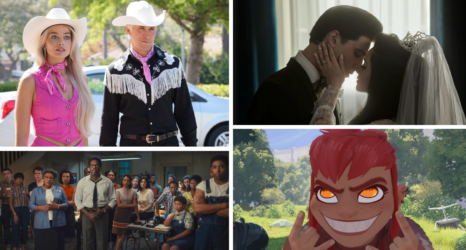This review contains spoilers.
If you have not yet found your way to The Good Place, it’s not too late. In fact, it’s never too late. That may be the ultimate message this snappy NBC sitcom is grinding away at, like a fork in the kitchen sink garbage disposal (wink to those in the know).
The premise across two seasons is this: Four faulty humans mistakenly sent to The Good Place after death are trying to improve themselves so as to earn their way into heavenly bliss for real. If they fail, they will be subjected to endless torture in The Bad Place, or—what may be worse—consigned to endless mediocrity in the form of warm beer and uninspired movie sequels in The Medium Place. In their quest to evade the ingenious tortures concocted by the bureaucratic demons of the netherworld, they get lessons in moral philosophy, take risks in the name of friendship, learn to trust each other and gain the self-knowledge necessary to understanding the morality of their actions.
A sitcom centered on moral understanding, let alone one that actually references philosophers like Kant and Kierkegaard, might seem like a buzzkill. But The Good Place is laugh-out-loud funny. Its peculiar combination of high-brow references and goofiness is utterly charming and original.
One of our hapless protagonists, Chidi, played to perfect pitch by William Jackson Harper, is a professor of moral philosophy: smart, earnest, serious, but hijacked by indecisiveness and its telltale stomach aches. Michael, the architect of The Good Place played by Ted Danson—a dapper demon who develops a sympathetic soft-spot for his human guinea pigs—told Chidi that Eleanor Shellstrop is his soulmate. But Eleanor, played by Kristen Bell, is a selfish, snarky slacker and party-girl—not an obvious match. Maybe with the help of Chidi’s lessons in moral philosophy, Eleanor will become the honest, caring, ethically sensitive match for her teacher. Maybe her impulsiveness and brio will rub off on him. Maybe.
But despite the centrality of this romantic narrative, The Good Place does not play the search for happy coupledom in the usual ways. Eleanor is not desperate for love, nor does her status as Chidi’s student make her into an adoring tag-along. Eleanor is, in fact, the clever one—who, episode after episode, figures out what’s really up and takes to leading her pack of pals. (I am reminded of Velma from the original Scooby Doo cartoons.) What’s better is that she not only takes on that role of leader, but is acknowledged as such by her peers; her male and female peers follow along, and even the master architect Michael seems to learn from her example.
Women rarely get this kind of recognition, on-screen or off. Kudos to The Good Place for giving Kristen Bell a role that is at once funny, smart and female-forward. To top it off, Bell is not required to doll herself up with a sexy veneer in order to make her character palatable. Her wardrobe is so beneath notice that I almost feel bad for the show’s costume designer, Kriston Mann. Almost.
Mann gets her chance to dress the cosmopolitan high-society philanthropist Tahani, brought to life by Jameela Jamil, in an endless array of floral dresses and stylish frippery. But Tahani’s fashion, rather than being an emblem of female power, is presented as just a piece of her affable narcissism, right alongside her incessant name-dropping and snooty aesthetics. Tahani’s character exists largely to create opportunities for making fun of celebrity culture, not for emulating it.
Mann also has fun outfitting Good Janet—the all-knowing android portrayed by D’Arcy Carden who serves as an assistant to Michael—and her doppelgänger, Bad Janet. While Bad Janet appears in black spandex pants, bleached blonde locks cascading over her shoulders, Good Janet wears a prim skirt suit with flouncy necktie. As every modern woman knows, we will be relentlessly assessed by our appearance. The obvious costume coding is fun, contributing a wry bit of commentary on our real-life tendencies to think we can read moral character off a person’s clothing choices. That we can be so misled is most apparent in the modest garb of Jianyu—Manny Jacinto’s take on a silent Tibetan monk who is really Jason, a wannabe DJ and rapper from Jacksonville.
Each of these idiosyncratic characters is strangely likeable. Consider Jason, who falls in love with the asexual Good Janet. Let me re-phrase that: Consider the love-match between the ultra-dumb Jason and Good Janet, who uploads to her operating system the entirety of human knowledge in a nanosecond. The writers of The Good Place clearly understand that love—whether human or android—is something of a glitch in the system.
Good Janet refuses the epithet “robot” but also refuses to be called what she is not: “woman.” Her repeated refusals echo what so many women experience: The constant need for self-assertion in a world that will not recognize you for what you are. In the case of women, “women” not girls or chicks or babes, and “human,” not an inhuman tool designed for use by men. By design, Good Janet issues her refusals and comments with incessant cheerfulness. This, too, highlights the demand on real-world women to smile and make nice—a demand that we act like servile robots.
Only a man as ingenuous and stupid as Jason could fall in love with a being like Good Janet, who is literally incapable of reciprocating human feeling. This is just one of the love matches that make The Good Place an enjoyable arena for social commentary. In the show’s picture of the afterlife, interracial couples are common and racial diversity is real and refreshingly unremarkable. At least, if The Good Place is what it pretends to be—a representation of otherworldly bliss—then it is apt that racial harmony is a feature of the neighborhood.
Given the show’s success here in integrating characters and actors of different races, it is disappointing that similar consideration has not been given to lesbian and gay characters. In seasons one and two, there are no same-sex soulmates, and lesbianism is treated, as it so often is, as titillating fodder—when Eleanor jokes about Tahani’s sex-appeal. I hope season three will surprise us with a rainbow.
All-in, there is much for a feminist to appreciate and laugh about in the The Good Place. Consider this from episode 10 of Season 2: At a party of demons in The Bad Place, one introduces himself by identifying his torture assignment. “Department of Toxic Masculinity,” he announces, noting that he can’t wait for the arrival of the creator of Girls Gone Wild.
A show that boldly denounces toxic masculinity can’t be all bad. It may even be good.





